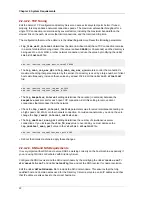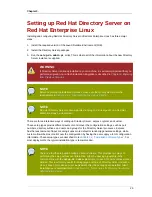
HP-UX 11i
17
* - nofile 8192
4. Edit the
/etc/pam.d/system-auth
, and add this entry:
session required /lib/security/$ISA/pam_limits.so
5. Reboot the Linux machine to apply the changes.
2.2.2.2.3. DNS Requirements
It is very important that DNS and reverse DNS be working correctly on the host machine, especially if
you are using TLS/SSL or Kerberos with Directory Server.
Configure the DNS resolver and the NIS domain name by the modifying the
/etc/resolv.conf
,
/
etc/nsswitch.conf
, and
/etc/netconfig
files, and set the DNS resolver for name resolution.
Edit the
/etc/defaultdomain
file to include the NIS domain name. This ensures that the fully-
qualified host and domain names used for the Directory Server resolve to a valid IP address and that
that IP address resolves back to the correct hostname.
Reboot the Red Hat Enterprise Linux machine to apply these changes.
2.2.3. HP-UX 11i
Directory Server runs on HP-UX version 11i only; earlier HP-UX versions are not supported. Directory
Server runs on a 64-bit HP-UX 11i environment as a 64-bit process.
Table 2.4, “HP-UX 11i”
lists the hardware requirements.
Section 2.2.3.1, “HP-UX Patches”
lists the
required patches, and the recommended system configurations are in
Section 2.2.3.2, “HP-UX System
Configuration”
.
Criteria
Requirements
Operating System
HP-UX 11i with the latest patches and upgrades
CPU Type
HP 9000 architecture with an Itanium CPU
Memory/RAM
256 MB minimum
1 GB RAM for large environments
Hard Disk
300 MB of disk space minimum for a typical
deployment
2 GB minimum for larger environments
4 GB minimum for very large environments
(more than a million entries)
You must use the
largefile
command to
configure database files larger than 2 GB.
Other
To run the Directory Server using port numbers
less than 1024, such as the default port 389,
you must setup and start the Directory Server as
root
, but it is not necessary to run the Directory
Server as
root
.
Table 2.4. HP-UX 11i
















































